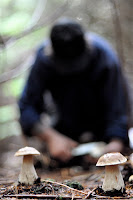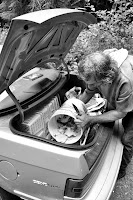OUT TO DINNER the other night, the chef came out of his kitchen to explain just how he liked to cook game hen (finishing it with a nob of sizzling butter was key, he said), and then, as we got to talking about mushroom hunting, it occurred to me that this same dish might go really well with a handful of button chanterelles. To make it more of a meal I added the parsnip puree.
1 game hen
2 tbsp butter
1 shallot, chopped
1/4 lb chanterelle buttons
splash Madeira
2 tbsp mascarpone
2 medium parsnips, peeled
heavy cream
salt and pepper
basil, chopped for garnish
1. Remove both legs (including thighs) of game hen, reserving rest of bird for another purpose. Pat dry, season, and saute over medium-high heat in half the butter, browning each side so the skin is dark and crispy and the meat tender. Add second tablespoon of butter to finish before removing legs to a plate and placing in 350 degree oven to keep warm.
2. While meat is cooking, cut parsnips into pieces, cover with water in small pot, and boil 15 minutes. Remove parsnips to food processor, add a spoonful of cooking water plus a little heavy cream, and puree.
3. Add chopped shallot to same pan and saute in pan juices until soft, a minute or two. Add mushrooms and stir. Cook another couple minutes before deglazing pan with a splash of Madeira wine. As wine and pan juices bubble and reduce, stir in a couple spoonfuls of mascarpone to thicken.
4. Remove meat from oven and pour any accumulated juices into mushroom sauce. Plate game hen leg over parsnip puree and top with chanterelles. Garnish with chopped fresh basil. Serves 2.
The fresh basil might seem a quixotic choice. It’s such a strong flavor, you rarely see it used as a garnish the way you see, say, parsley. But in this case it did a really good job of balancing the sweetness of the parsnip and brightening the overall dish. Basil peaked in or garden recently and we’re using it as much as possible; combined with the high season of chanterelles, the pairing seemed like a good idea—and indeed I plan to find other ways to bring these two ingredients together, idiosyncratic or not.




















